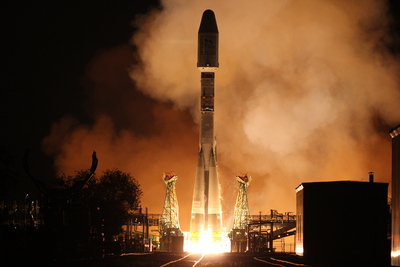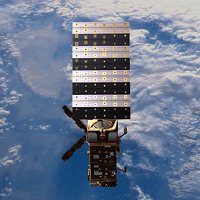Climate watch – Europe’s second polar-orbiting weather satellite launched

The second Metop satellite was launched yesterday from the Baikonur cosmodrome, in Kazakhstan, atop a Russian Soyuz launcher. Metop-B will ensure the continuity of the weather and atmospheric monitoring service provided by its predecessor Metop-A, which has been circling the globe from pole to pole, 14 times a day, since 2006 and has now exceeded its design lifetime.
The Soyuz-Fregat vehicle lifted off at 16:28 UTC on Monday, September 17, 2012. The Fregat upper stage manoeuvred to release the satellite into a polar orbit at an altitude of 810 km some 69 minutes later, over the Kerguelen Archipelago, in the Indian Ocean.
Metop-B, developed for EUMETSAT’s polar satellite system, is now under the control of ESA’s Operations Centre in Darmstadt, Germany.
In the coming days, its systems will be tested before it is handed over to EUMETSAT, also based in Darmstadt, for six months of commissioning of its payload before entering routine service with Metop-A.
Volker Liebig, ESA’s Director of Earth Observation Programmes, commented: “Metop-B will become operational while Metop-A is still active and performing well. This will ensure the continuity of the service without any risk of interruption in the data feed. Meanwhile, we are working with EUMETSAT to prepare the future with the second generation of European polar satellites.”
Unlike the Meteosat satellites, which are watching about half of our planet from a fixed vantage point almost 36 000 km above the Gulf of Guinea, Metops work at lower altitude and fly over the whole globe to provide additional data on the atmosphere.
 Beyond weather monitoring, the Metop and Meteosat satellites are part of ESA’s effort on climate watch, which includes the experimental Earth Explorer satellites, to probe Earth and its atmosphere.
Beyond weather monitoring, the Metop and Meteosat satellites are part of ESA’s effort on climate watch, which includes the experimental Earth Explorer satellites, to probe Earth and its atmosphere.
Three Earth Explorers have been launched since 2009 – the GOCE gravity mapper, the SMOS water satellite and the CryoSat ice satellite – and more are in preparation.
In 2013, ESA will start launching Sentinel satellites to monitor our environment and climate under the Global Monitoring for Environment & Security (GMES) initiative with the European Commission.
The Metop satellites are Europe’s first operational meteorological satellites in polar orbit. They constitute the space segment of the EUMETSAT Polar System (EPS) delivering data for numerical weather prediction (NWP) – the basis of modern weather forecasting – and climate and environmental monitoring.
Flying at an altitude of 817 km, each Metop satellite carries the same sophisticated suite of instruments providing fine-scale global data, which can only be gathered in the low Earth orbit, such as vertical profiles of atmospheric temperature and moisture, wind speed and direction at the ocean surface, and some atmospheric trace gases.
Observations from Metop-A have significantly improved weather forecasts up to 10 days ahead. These forecasts are essential to protect life and limit damage to property, but they also benefit the weather-sensitive sectors of the European economy, especially energy, transportation, construction, agriculture and tourism.
The three Metop satellites, launched sequentially, will provide continuous data until 2020.
Source: ESA
Images courtesy of ESA

Commenting rules and guidelines
We value the thoughts and opinions of our readers and welcome healthy discussions on our website. In order to maintain a respectful and positive community, we ask that all commenters follow these rules.